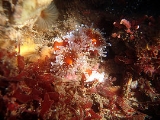
Corynactis californica
Encyclopedia
Corynactis californica is a bright red colonial anthozoa
n similar to sea anemone
s and scleractinia
n stony corals. Unlike the Atlantic true sea anemone, Actinia fragacea, that bears the same common name, strawberry anemone, this species is a colonial animal of the order Corallimorpharia
. Other common names include club-tipped anemone and strawberry corallimorpharian. The anemone is known to carpet the bottom of some areas, like Campbell River
in British Columbia
, and Monterey Bay
in California
.
The strawberry anemone grows no larger than 2.5 centimeters. The anemone is always bright red with transparent to white tentacles that are bulbous at the tips. The strawberry anemone resembles sea anemones in that they lack a calcareous skeleton, but are closer related to stony corals in that they lack basilar muscles.
The strawberry anemone is found in water deeper than ten feet and may not be visible in intertidal pools
. When held and raised in captivity, the strawberry anemone may be fed on tiny crustaceans including brine shrimp
. Aquarium hobbyists integrating Corynactis californica into live coral settings provide hard stubstrates for colonial expansion, since this species kills coral and anemones when competing for resources. Like most cnidarians, the strawberry anemone can replicate both asexually (cloning) and sexually through polyp dispersion.
Live examples of Corynactis californica can be viewed in many Pacific aquariums including the Monterey Bay Aquarium
.
Anthozoa
Anthozoa is a class within the phylum Cnidaria that contains the sea anemones and corals. Unlike other cnidarians, anthozoans do not have a medusa stage in their development. Instead, they release sperm and eggs that form a planula, which attaches to some substrate on which the cnidarian grows...
n similar to sea anemone
Sea anemone
Sea anemones are a group of water-dwelling, predatory animals of the order Actiniaria; they are named after the anemone, a terrestrial flower. Sea anemones are classified in the phylum Cnidaria, class Anthozoa, subclass Zoantharia. Anthozoa often have large polyps that allow for digestion of larger...
s and scleractinia
Scleractinia
Scleractinia, also called stony corals, are exclusively marine animals; they are very similar to sea anemones but generate a hard skeleton. They first appeared in the Middle Triassic and replaced tabulate and rugose corals that went extinct at the end of the Permian...
n stony corals. Unlike the Atlantic true sea anemone, Actinia fragacea, that bears the same common name, strawberry anemone, this species is a colonial animal of the order Corallimorpharia
Corallimorpharia
Corallimorpharia is an order of marine cnidarians closely related to the true sea anemones . They are mostly tropical, with a narrow column topped with a wide oral disc. The tentacles are usually short or very short, arranged in rows radiating from the mouth. Many species occur together in large...
. Other common names include club-tipped anemone and strawberry corallimorpharian. The anemone is known to carpet the bottom of some areas, like Campbell River
Campbell River, British Columbia
Campbell River is a coastal city in British Columbia on the east coast of Vancouver Island at the south end of Discovery Passage, which lies along the important coastal Inside Passage shipping route...
in British Columbia
British Columbia
British Columbia is the westernmost of Canada's provinces and is known for its natural beauty, as reflected in its Latin motto, Splendor sine occasu . Its name was chosen by Queen Victoria in 1858...
, and Monterey Bay
Monterey Bay
Monterey Bay is a bay of the Pacific Ocean, along the central coast of California. The bay is south of San Francisco and San Jose, between the cities of Santa Cruz and Monterey....
in California
California
California is a state located on the West Coast of the United States. It is by far the most populous U.S. state, and the third-largest by land area...
.
The strawberry anemone grows no larger than 2.5 centimeters. The anemone is always bright red with transparent to white tentacles that are bulbous at the tips. The strawberry anemone resembles sea anemones in that they lack a calcareous skeleton, but are closer related to stony corals in that they lack basilar muscles.
The strawberry anemone is found in water deeper than ten feet and may not be visible in intertidal pools
Tide pool
Tide pools are rocky pools by oceans that are filled with seawater. Many of these pools exist as separate entities only at low tide.Tide pools are habitats of uniquely adaptable animals that have engaged the special attention of naturalists and marine biologists, as well as philosophical...
. When held and raised in captivity, the strawberry anemone may be fed on tiny crustaceans including brine shrimp
Brine shrimp
Artemia is a genus of aquatic crustaceans known as brine shrimp. Artemia, the only genus in the family Artemiidae, has changed little externally since the Triassic period...
. Aquarium hobbyists integrating Corynactis californica into live coral settings provide hard stubstrates for colonial expansion, since this species kills coral and anemones when competing for resources. Like most cnidarians, the strawberry anemone can replicate both asexually (cloning) and sexually through polyp dispersion.
Live examples of Corynactis californica can be viewed in many Pacific aquariums including the Monterey Bay Aquarium
Monterey Bay Aquarium
The Monterey Bay Aquarium is located on the former site of a sardine cannery on Cannery Row of the Pacific Ocean shoreline in Monterey, California. It has an annual attendance of 1.8 million visitors. It holds thousands of plants and animals, representing 623 separate named species on display...
.

